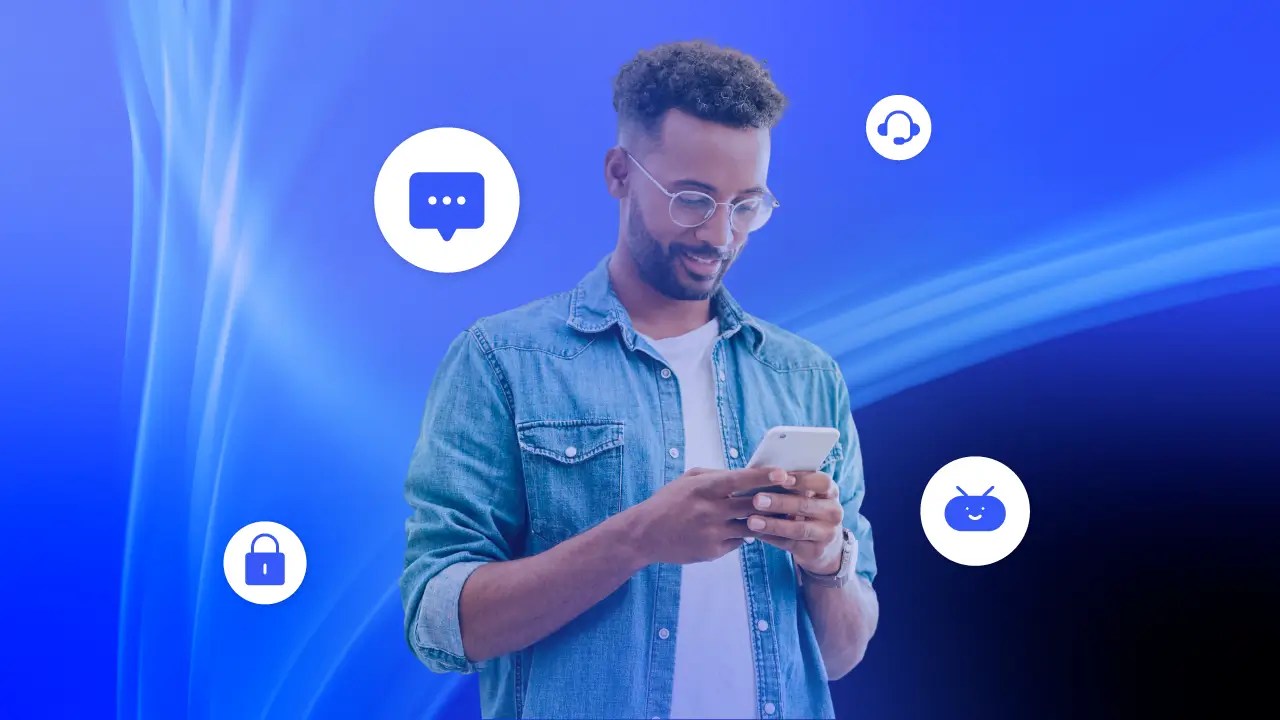Text messaging is a core element of business communications, enabling people to have quick conversations on their phones and computers. It’s especially useful in sales and marketing, giving agents and reps new ways to communicate with customers.
While using SMS (short message service) and MMS (multimedia messaging service) text messaging for business communications isn’t a new concept, two-way messaging is an effective but often overlooked tool.
But what is two-way text messaging, and how can businesses use it to engage with customers? Let’s explore.
What Is Two-Way SMS?
Two-way SMS is a business communications channel that allows companies to communicate with customers via text, including sending and receiving messages.
Traditional SMS marketing is a one-way process: the company messages the user, but the user can’t reply directly. For instance, if you receive a text reminding you about an appointment but have no way to respond to confirm or cancel it, that’s a one-way SMS in action. However, two-way SMS enables real-time, interactive conversations, providing more opportunities for customer engagement and relationship building.

Benefits of Two-Way SMS
There are some specific benefits to two-way SMS that make it a useful option for many businesses, which other channels might not provide.

High open rates
One of the first benefits of two-way SMS marketing is the high open rate. Customers and leads are significantly more likely to open text messages than email or other digital channels, so if you want to make sure your customers see your message, SMS messaging is far more likely to grab their attention.
Immediate response
Not only are customers more likely to open SMS messages, but they can also reply easily and instantly. The speed and convenience of text messaging can lead to quick customer engagement and speedy resolutions.

Even if the customer doesn’t answer immediately, they can still reply at their convenience.
Personalization
SMS messaging is particularly easy to tailor to individual customers. Agents can craft messages based on the customer’s preferences, past interactions, and other pertinent information, creating a personalized customer experience.
Cost-effective
SMS marketing is generally more affordable than other marketing channels. Most messaging plans provide a large number of free messages per month, with reasonable rates for messages over the limit, making it a cost-effective option.
Increased engagement
Two-way SMS messaging provides a key benefit that many other marketing channels don’t: the ability for customers and agents to converse. The back-and-forth of text messaging creates an actual conversation between the customer and the brand, fostering stronger customer relationships and a more genuine customer experience than other channels.
Practical Use Cases for Two-Way SMS
While two-way messaging provides several benefits, you’ll still need to know where, when, and how to use it to truly get value from this channel. Let’s look at several ways you can use two-way SMS messaging across departments and industries.

Customer support
One of the most common and helpful uses for two-way SMS is for customer support. Customers can contact support teams directly through their mobile phones, a quick and painless method.
Additionally, SMS messaging empowers agents to provide immediate responses to customer inquiries. SMS messaging allows agents to troubleshoot and resolve problems through text-based conversations, connecting with and helping customers on the channel of their choice.
Customers can book, reschedule, or manage appointments via SMS if they need further assistance.
Marketing and sales
Organizations of all types and sizes can also use SMS messaging for marketing and sales, connecting with customers via text conversations to build better customer relationships. Companies can capture leads through SMS opt-ins and qualification questions, after which they can offer exclusive deals and discounts via text messaging.

Additionally, SMS messaging is a convenient way to send customer surveys and gather feedback. Customers can either reply to survey questions via text or receive a link directing them to the survey, which they can fill out at their leisure. This helps companies gather feedback and insights without keeping customers on the phone, increasing response rates.
Organizations can also send automated appointment reminders, including the option to confirm or cancel appointments via SMS. This makes it easier for customers to manage their appointments and has been shown to increase show-up rates — sometimes, it just takes a little reminder.
Of course, companies can also provide personalized offers and rewards via SMS. Many businesses offer loyalty programs where customers can receive special deals or discounts, and SMS messaging is a convenient way to connect with customers and inform them about the latest offers.
Healthcare
Looking at more specific vertical markets, several use cases exist for two-way SMS in healthcare. One of the most significant use cases is the ability to provide patients with information and updates, such as test results, medication refills, and treatment plans — it’s a simple way to reach patients while making the information easily accessible instantly.
In addition to appointment reminders with the ability to reschedule or cancel appointments, SMS messaging can provide medication reminders, helping patients adhere to their medication schedules.
Education
Educational institutions can use SMS messaging to connect with students and parents. For instance, schools can send text message alerts, announcements, and reminders to keep students updated and aware of upcoming events. Students can register for events and activities, while the admissions team can connect with potential students and answer any questions they may have.
Teachers can use two-way SMS messaging to send group reminders for homework assignments or notify their classes of any sudden changes, such as cancellations or relocation. This way, if a class gets canceled, students won’t be left standing outside the classroom wondering why no one else is there.
Other industries
The uses for two-way SMS extend to many other vertical markets.
For instance, the transportation industry has embraced SMS messaging to update customers about airline, train, and bus schedules. This way, passengers will know about delays as soon as possible, rather than rushing to the airport only to find out their flight was pushed back an hour.
Financial institutions can use SMS messaging to send customers alerts and information. Suppose a bank detects a suspicious purchase, for example. In that case, they can instantly send fraud alerts and ask the customer to confirm the purchase is legitimate before freezing their credit card.
In the age of food delivery apps and mobile ordering, restaurants have also taken to SMS messaging. Customers sign up on virtual waitlists and receive text messages when their table is ready. Some restaurants even allow customers to place orders via text message.
When to Use SMS vs MMS
While we’ve primarily discussed SMS, MMS is also a valuable tool for communicating with customers.
SMS is text-only, but MMS messaging allows users to send and receive images, videos, audio files, and other forms of multimedia. This enables businesses to send various content, such as instructional videos, graphics, photos, and more.
When to use SMS
SMS is limited to text messages only, so it’s perfect for short messages that don’t require extra content. It’s a quick and effective method when you need to answer a question, provide an update, or confirm an appointment.
When to use MMS
MMS messaging, on the other hand, is an excellent choice for sharing rich media content. It’s perfect for product showcases, event promotions, and any other form of visual storytelling. So, if you want to show off a new product, include a video, or even send a GIF that the customer will enjoy, you’ll want to use MMS messaging.
Solve Two-Way Business Texting With Nextiva
People are on their phones more than ever, which means that organizations embracing mobile messaging will be able to reach customers on the devices and channels they prefer.
Out of all the marketing and outreach channels organizations can use, two-way SMS and MMS messages have some of the highest chances of being seen and replied to. So, whether you’re a marketing professional, sales rep, or event organizer, text messaging is an essential tool.
No matter how you use bidirectional SMS/MMS, Nextiva’s business messaging features enable you to connect with your customers quickly. You can send and receive text messages from a business phone number on your desktop, laptop, or mobile phone, and the messages instantly sync across devices.
Companies using Nextiva for their SMS/MMS messaging have been able to connect with more customers and drive conversions. For instance, Charter Global improved its connection rate by 5% and increased conversions by 8% after its teams started using Nextiva for business messaging.
Whatever your business and your text messaging needs, Nextiva has the features and tools you need to comfortably, reliably, and efficiently message and connect with your customers.
Connect with customers anywhere. Learn more about business text messaging with Nextiva.
Customers love businesses that text.
Meet prospects and customers where they prefer with easy-to-use text capabilities that increase conversions and build loyalty.

















 Customer Experience
Customer Experience 









